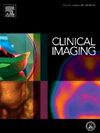Ultrasonographic assessment of the risk of free-floating thrombus detachment in the lower extremity deep veins in patients with fracture
IF 1.8
4区 医学
Q3 RADIOLOGY, NUCLEAR MEDICINE & MEDICAL IMAGING
引用次数: 0
Abstract
Objective
To explore the ultrasonographic features and influencing factors of free-floating thrombus (FFT) detachment in the lower extremity deep veins (LEDVs) of patients with fractures.
Methods
Clinical data of patients diagnosed with FFT in the LEDVs and implanted with an inferior vena cava filter (IVCF) in our hospital between July 2021 and August 2023 were retrospectively analysed. The patients were divided into the thrombus detachment group (the experimental group, n = 92) and the non-thrombus detachment group (the control group, n = 103) based on the presence of detached thrombus in the IVCF. The effects of thrombus echogenicity, floating degree, thrombus location, thrombin time, D-dimer and fibrinogen on thrombus shedding were analysed. The nomogram method was used to establish the model and predict the probability of delayed postoperative recovery.
Results
The proportions of patients with extremely hypoechoic thrombus and medium and high floating degrees increased in the experimental group compared with those in the control group, and the differences between the two groups were statistically significant (P < 0.05). Extremely hypoechoic thrombus (P = 0.021, 95 % CI: 1.109–13.748) and high (P = 0.001, 95 % CI: 3.854–28.573) and medium floating degrees (P = 0.004, 95 % CI: 1.792–13.453) were risk factors for deep veins FFT (DV FFT) detachment. The results of receiver operating characteristic curve analysis showed that the area under the curve of the model was 0.893, with a 95 % CI of 0.856–0.937, indicating a high prediction accuracy.
Conclusion
Ultrasonographic parameters, including thrombus echogenicity and floating degree, are valuable in predicting DV FFT detachment in patients with traumatic fractures, providing references for IVCF implantation.
对骨折患者下肢深静脉自由浮动血栓脱落风险的超声评估
方法回顾性分析我院2021年7月至2023年8月期间诊断为下肢深静脉血栓(FFT)并植入下腔静脉滤器(IVCF)的患者的临床资料。根据 IVCF 中是否存在脱落血栓,将患者分为血栓脱落组(实验组,n = 92)和非血栓脱落组(对照组,n = 103)。分析了血栓回声、漂浮程度、血栓位置、凝血酶时间、D-二聚体和纤维蛋白原对血栓脱落的影响。结果 实验组与对照组相比,血栓极低回声、中高漂浮度患者比例增加,两组差异有统计学意义(P <0.05)。极低回声血栓(P = 0.021,95 % CI:1.109-13.748)、高回声血栓(P = 0.001,95 % CI:3.854-28.573)和中回声血栓(P = 0.004,95 % CI:1.792-13.453)是深静脉血栓脱落的危险因素。结论超声参数,包括血栓回声性和漂浮度,对预测创伤性骨折患者的深静脉FFT脱落很有价值,可为IVCF植入提供参考。
本文章由计算机程序翻译,如有差异,请以英文原文为准。
求助全文
约1分钟内获得全文
求助全文
来源期刊

Clinical Imaging
医学-核医学
CiteScore
4.60
自引率
0.00%
发文量
265
审稿时长
35 days
期刊介绍:
The mission of Clinical Imaging is to publish, in a timely manner, the very best radiology research from the United States and around the world with special attention to the impact of medical imaging on patient care. The journal''s publications cover all imaging modalities, radiology issues related to patients, policy and practice improvements, and clinically-oriented imaging physics and informatics. The journal is a valuable resource for practicing radiologists, radiologists-in-training and other clinicians with an interest in imaging. Papers are carefully peer-reviewed and selected by our experienced subject editors who are leading experts spanning the range of imaging sub-specialties, which include:
-Body Imaging-
Breast Imaging-
Cardiothoracic Imaging-
Imaging Physics and Informatics-
Molecular Imaging and Nuclear Medicine-
Musculoskeletal and Emergency Imaging-
Neuroradiology-
Practice, Policy & Education-
Pediatric Imaging-
Vascular and Interventional Radiology
 求助内容:
求助内容: 应助结果提醒方式:
应助结果提醒方式:


